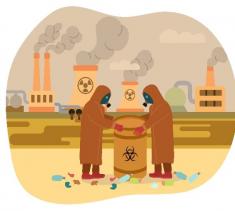Principles on human rights and the protection of workers from exposure to toxic substances, Special Rapporteur on toxics and human rights

Sub-title: Safe industrial operations and enhanced accident prevention, preparedness and emergency response measures are needed to protect human rights, society and the environment
Country: Global
Date: 2018-2019
Category: Policy
Tags: Principles on Human Rights and Toxins, Siting of Chemical/Industrial Facilities, Industrial Safety, Occupational Health & Safety
Organization(s) involved: OHCHR (Office of the United Nations High Commissioner for Human Rights) – Special Rapporteur on toxics and human rights
In September 2019, the former Special Rapporteur on human rights and toxics presented a report (A/HRC/42/41) to the UN Human Rights Council, with fifteen principles to better protect workers from the exposures to toxins and to provide remedies for violations of workers’ rights. The principles are based on existing international human rights law, the UN Guiding Principles on Business and Human Rights, several ILO instruments, and taking into account relevant international agreements on industrial safety, toxic chemicals and waste, such as the UNECE Convention on the Transboundary Effects of Industrial Accidents (Industrial Accidents Convention). These principles are the result of comments and suggestions received through written submissions; consultations with States, international organizations, civil society, and other stakeholders; and twenty-five years of research and analysis through the “toxics” mandates’ country visits, thematic reports, and communications with States and non-State actors.
With respect to industrial accident prevention, preparedness and response, Principle 2 – States have a duty to protect the human rights of workers through the prevention of exposure to toxic substances is relevant. This Principle provides that every State has an obligation to adopt measures to prevent occupational exposure to toxic substances (including hazardous substances that are listed under Annex I of the UNECE Industrial Accidents Convention for the purposes of defining “hazardous activities”). Pursuant to their duty to protect the right to life, States are also required to take special measures of protection towards persons in vulnerable situations whose lives have been placed at particular risk because of specific threats, such as workers. Prevention of exposure requires deliberate action by States. States must do everything in their power to protect all workers in their territory and/or jurisdiction from occupational exposures to toxic substances. States must take appropriate steps to prevent, investigate, punish and provide redress for cases of occupational exposures to toxic and otherwise hazardous substances through effective policies, legislation, regulation and enforcement, as well as adjudication. (para 31)
With respect to decisions on the siting of hazardous industrial/chemical facilities, Principle 7 – Protecting workers from exposure to toxic substances protects their families, their communities and the environment, is relevant. This Principle provides that when a worker is exposed to a toxic workplace, the consequences of such exposure stretch far beyond their well-being and violations of their rights. The physical and mental consequences of such exposure are also borne by their families and generally lead to a toxic environment for their communities. Workers engaged in highly toxic livelihoods often work very close to their homes and communities, sometimes accompanied or helped by their children. In addition, the siting of homes, schools and other sensitive land uses in proximity to hazardous industrial activities poses serious risks in the event of an industrial accident involving toxic substances – not just to workers, but to their families and communities who could be gravely affected by the release of toxins and pollution (see A/75/290 para. 11).
Safe industrial operations, enhanced accident prevention, preparedness and emergency response measures by industry in coordination with government, emergency services and the public, and the protection of workers from toxic exposures therefore has broader benefits for society and the environment. The report (A/HRC/42/41) highlights that potential synergies can be realized through stronger cooperation between labour and environmental health efforts at all levels of governance.
The details of this good practice can be found at:
- The Principles on protecting workers from exposure to toxics report (A/HRC/42/41) (2019), available in the six UN official languages
- OHCHR’s webpage: https://www.ohchr.org/EN/Pages/Home.aspx
- A/75/290 para 11 https://undocs.org/en/A/75/290
For information about the EIB and UNECE Information Repository of Good Practices and Lessons Learned in Land-Use Planning and Industrial Safety and to access case studies from other countries, please visit the navigation page.

